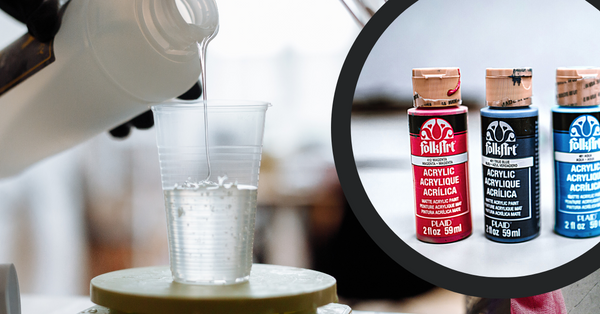
Creating beautiful resin art pieces can be fun and rewarding, however if you want to add a unique and personal touch to your projects, painting the resin is an excellent way to do it. You may have heard that acrylic paints are the best option for this task, but can you use acrylic paint on resin? The answer is – yes! But there are some steps you need to take to make sure the paint adheres well, as painting resin is very different from painting on a standard canvas!
Keep reading to learn a few more tips and tricks for getting the best results when painting resin with acrylics!
TABLE OF CONTENTS
- What Kind of Acrylic Paint Should I Use?
- Using Acrylic Paint on Resin – Pros and Cons
- A Step by Step Guide to Painting on Resin with Acrylics
- Tips & Tricks to Create Beautifully Painted Resin Pieces
- Frequently Asked Questions
Which Kind of Acrylic Paint Should I Use?
When deciding on what kind of acrylic paint to use for your resin project, the possibilities are endless. There’s more expensive and less expensive options, as well as many different kinds of flashy colors and effects you can apply.
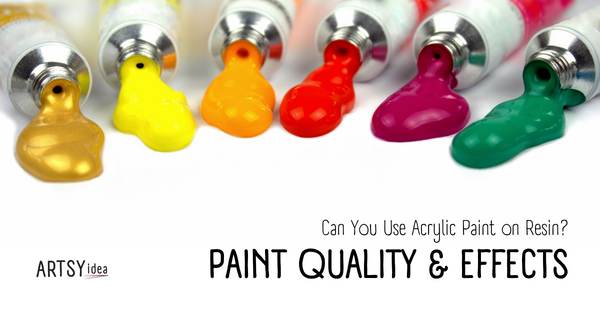
- Quality – Paint made by brands such as Winsor and Newton hold a higher pigment, but come with a greater price. These products will produce a higher quality piece while using less paint in the process. You can also opt for a more affordable choice such as Caliart. You may find the pigmentation to be on the weaker side, and therefore, you might end up using more of the product in the long run.
- Colors and Effects – There are a wide variety of acrylic paint colors to choose from, and some may even have added effects to spice up your project. FolkArt carries an acrylic paint pack that features a glitter finish for some added sparkles. They also sell a neon backlight set that will give your resin piece a cool finish. Want to go for more of a metallic finish? Try out this paint set by Hissico to give your final piece a shiny, metallic look.
Using Acrylic Paint on Resin – Pros and Cons
When deciding what paint to use on your resin, it’s always important to weigh out the good and the bad. While resin can also be painted with metalized or enamel paints, acrylic is more often than not a worthy choice over the others. Its versatility and style is superior when used with resin, and it makes clean up time a lot easier.

Pros of Using Acrylic Paint on Resin
- Easy Clean Up – Using acrylic paint can make fixing mistakes on your resin canvas a breeze. As long as the mistake is fresh and you catch it quickly, you can simply wipe the paint away with a dampened towel.
- Layers for Effects – Painting with acrylics on resin requires many layers to be used. While this will increase the overall production time of your piece, it gives you options to make many unique twists and designs on it. You can add glitter in at certain places, or use tape to create endless patterns.
- Quick Drying – Acrylic paint is a fast drying paint, making it ideal to use for resin. The drying time between the many layers you will need would be less than using other paints. It will take longer with the more layers you add; however, more layers means a more solid finish.
Cons of Using Acrylic Paint on Resin
- Again, Layers – As said above, the amount of layers needed during the process may prove difficult to create the desired effect on your product. You will need to be patient and choose your colors, effects, and layers with caution. You will also need to wait for each layer to dry before applying another one. However, creating simple opaque designs is easier than it is with other paints.
- Work Quickly – Just like the layers, the fast drying effect of acrylics can be a blessing and a curse in disguise. Since the paint dries so quickly, you will need to keep up the pace when painting, all the while being careful your design comes out correctly.
A Step-by-Step Guide to Painting on Resin with Acrylics
Now that you know whether or not acrylics are right for your project, it’s time to get started. Before painting, it’s important to prepare the resin piece properly. The biggest problem with painting resin is getting the paint to adhere to the surface.
Resin doesn’t have a porous surface like some other materials. Each step during the process will make this task a lot easier, starting with thorough sanding, and finishing off with a protective sealant. Let’s get started.
Preparing Your Resin
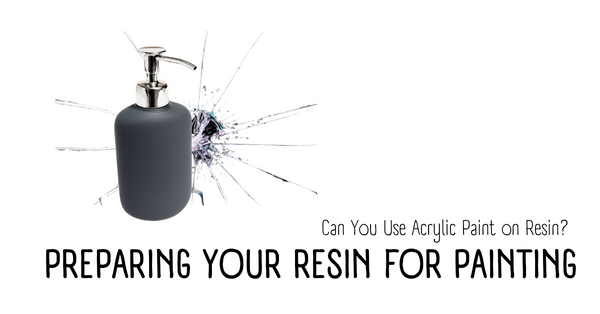
- Soap/Rinse – You’ll want to start off by giving your resin object a good cleaning. All you need to clean it with is some lukewarm, soapy water. Take a cloth and dampen it with the solution, wiping off any dirt or dust on the product.
- Cracks – If there are any small cracks or holes that debris may get stuck in, you may use something such as a toothbrush to get it nice and clean.
Cleaning off your piece will prevent foreign debris from getting stuck on your piece while painting. Carefully dry the resin off, and give it a once over to check that it’s all clean and dry.
Sanding Your Resin
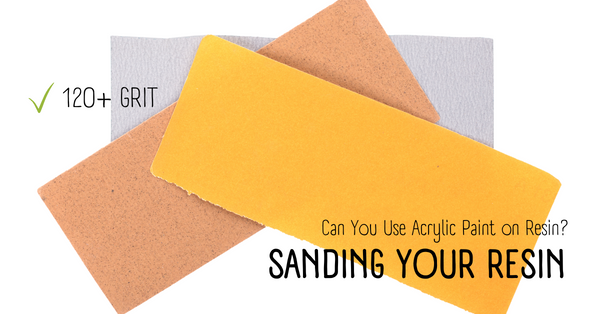
- What Grit and Why – To make sure the paint adheres to your work properly, you will need to sand it down with some very fine grit sandpaper. That way, the texture of your product won’t change during the process, and it will still give off a polished and professional look. Levels ranging of 120 or more grit should work for polishing a resin piece. Doing this before painting is just one small step to ensure the paint sticks to your product.
- How to Sand – During the sanding process, you’ll want to go in small circular motions, making sure the surface is being raised equally. Don’t worry about holes or cracks, we will get to that in a moment. After checking over your product for any missed spots, you can clean off any residue with a damp cloth or a can of compressed air.
Filling Holes & Bubbles
Let’s face it, painting on resin surfaces is already hard. Bubbles and holes can make painting small details harder by having to move around them. Here are some ways to fix and avoid this.

- Fixing Holes – To fill holes or recesses within your piece, you can simply add in some epoxy filler and let it dry as directed on the product instructions. After this, sand the filler to blend it with the resin.
- Fixing Bubbles – If bubbles are a sixteenth of an inch or less, you can mix up a new coat of resin and flood coat the area. Make sure to use the proper amount of doming resin, which levels itself out to one-eighth inch depth. Art Resin is a good choice for this for its notoriously thicker consistency. If the dimples are still visible, you’ll need to apply more coats and do some sanding in the affected areas.
- Future Prevention – To prevent future holes or bubbles, be sure to mix your resin with the hardener slowly. This part of the process is often where they are formed. Keep the room you are mixing in at a consistent temperature of 75 degrees fahrenheit. When pouring your resin, try to do it in thin ⅛” layers. You’ll need to pour very slowly and as close to the mold as you can. If you have anything to include in the mold such as flowers or leaves, make sure they are dried out thoroughly to prevent bubbles.
Applying Primer to Your Resin Piece
Now that you got all of that out of the way, it’s time to add another step in ensuring the paint sticks to the surface of the smooth resin. It’s a very important step in the process to ensure that your product will maintain longevity.
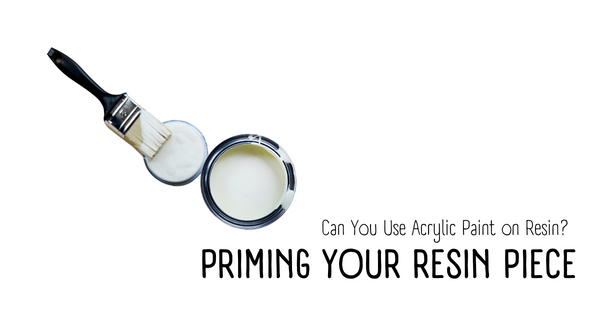
- Layers – You’ll want to start applying multiple coats of primer, letting it set to dry between each one. Give it a good sanding, then apply the next coat. Always wear safety gear when handling primer, and be thorough and patient in this process.
- Types of Primers – When deciding what kind of primers to use, we suggest Krylon ColorMaster Paint. It dries super quickly between coats and doesn’t have an overwhelmingly bad smell to it. They also have a 10 minute drying, moisture proof primer that would be an ideal choice for products you’d like to keep in good condition for a long time.
Painting Your Resin
Now that your piece is ready to paint, it’s time to give your favorite color a good stir. Carefully apply thin coats of your desired paint over the surface of the resin. Once you are done, let it dry for the suggested time period on the product instructions.

- Be Patient! – Once you are sure the acrylic paint has dried on your product, apply your second layer. This entire process takes time and patience, so be sure to double check the dryness of the paint between layers. Failure to do so can result in messy designs as an outcome.
Applying a Sealant
You’ve taken the time to apply layer after layer, so it’s time to seal the deal on your work of art with a protective varnish. This will shield your piece from UV rays and prevent chipping in the future.
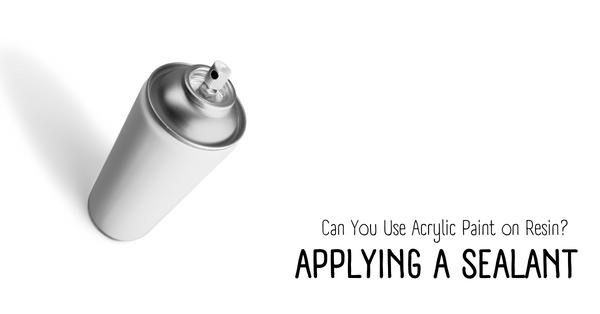
- What Kind to Use – There are many kinds of varnishes out there, but Krylon Triple Thick Clear Glaze can get the job done for anything you’re sealing. Just give an even layer of spray over the painted surface, and let it dry properly. You can also use Mod Podge Spray, which has a low odor and will do the job for most indoor pieces.
Tips and Tricks for Painting with Acrylics on Resin
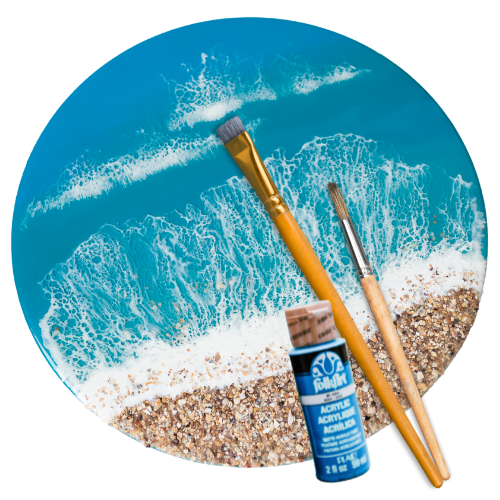
Now that you have a solid grasp on how to paint on resin with acrylic paints, here are a few tips and tricks to keep in mind:
Use Quality Brushes – Always use high quality brushes and paint to ensure your product comes out best. Artify sells a set of 24 synthetic brushes that are used and praised by artists all over.
Ventilation/Protection – Always wear gloves and proper protective gear while painting. Try to do this in an outdoor or well ventilated area.
Take the Extra Step – When you apply primer and a sealant, that extra step just makes sure that all the hard earned work you made will last. You wouldn’t want all those layers you painted to go to waste.
Don’t apply until it’s dry! – Make sure you let each layer dry before applying the next coat, be it more primer or paint.
Seal the deal – Make sure you seal your work so it stand the test of time.
To sum up…
It’s official, you can use acrylic paint on resin! Now that we’ve cleared that up, hopefully, you feel inspired to try your hand at painting with acrylics on resin – and create some beautiful and unique pieces of art! So have fun and let your creativity flow!
Frequently Asked Questions
What happens if you put acrylic paint in resin?
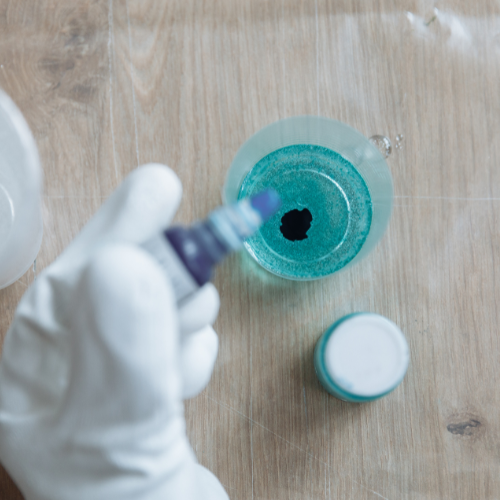
Acrylic paint is a great choice of colorant for epoxy resin. It’s easy to find and affordable, not to mention it comes in a wide variety of colors and effects, from metallic to glitter, so you can get really creative with your resin pieces. However, there are some careful steps you need to follow when mixing acrylic paint with resin to ensure a vibrant and long-lasting finish – check out this article for tips on mixing acrylic paint with resin.
Can I paint on epoxy resin?
Yes, you can absolutely paint on epoxy resin! Painting on epoxy resin can be a great way to create unique and eye-catching works of art. You can use epoxy paint, acrylic paint, alcohol inks, or any medium that works with resin as its base – the possibilities are endless!
Which acrylic paint is best for resin?
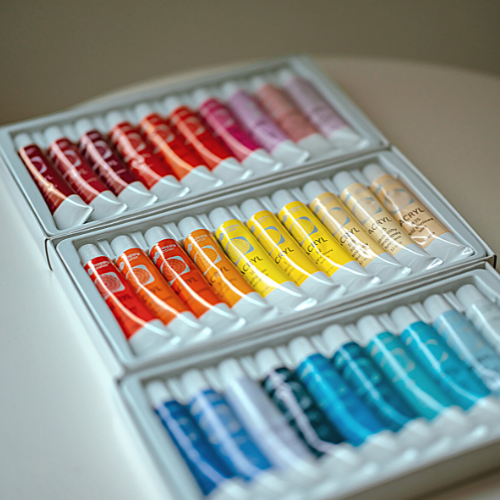
To find the best acrylic paint for resin art, it’s important to understand that there is no one-size-fits-all answer. Different kinds of paints work better in various conditions and settings. For example, if you are looking to tint or mix colors with your resin, then liquid acrylic paint can be a great solution, like Golden Fluid Acrylics, which are highly revered by resin artists everywhere.
However, if you’re more focused on creating a strong opaque effect while using resin then it may be better to opt for a thicker variety like high-flow or heavy body acrylics. Ultimately, choosing the right acrylic paint depends on what type of art you are creating and what look and feel you are hoping to achieve. That said, professional grade paints are generally preferred since the pigments are usually brighter and have better coverage than their student counterparts.
Before investing in paints for your next resin project, consider your desired effects and try experimenting with different formulations until you find one that works best for you.
Some other articles you might like

Can You Mix Acrylic Paint with Resin?
Tips to Create Beautiful & Vibrant Colored Resin

Can You Use Acrylic Paint on Glass?
A Step-by-Step Guide for Flawless Glass Painting


